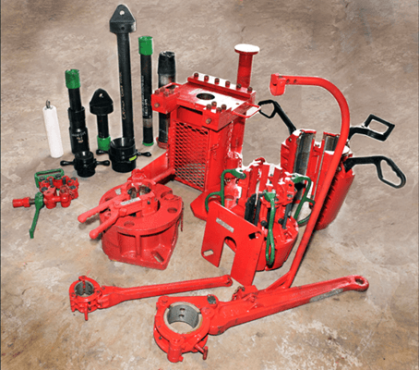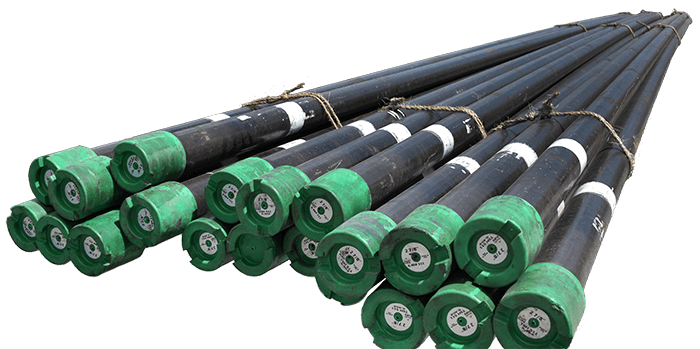Offshore Gravel Pack Support Equipment
A primary objective of gravel packing is formation stabilization while causing minimal impairment to well productivity. A steel screen is placed in the wellbore and the surrounding annulus is packed with prepared gravel specifically sized to reduce the passage of formation sand.
Gulfstream Services, Inc. provides a full array of Offshore Gravel Pack Equipment, including various sizes of wash pipe, screen tables and related handling tools, as well as Chiksan® support iron, R-STOP engineered restraints and other tools.
Offshore Handling Tools & Wash Pipe
We offer a full assortment of handling tools to help you complete any offshore job including clamps, lift subs, I.D. drifts, work plates, rotary slips, lift nubbins, screen tables, bowls and slips, becket and bails, bottleneck elevators, hand tongs (K-20 – K-50), and square shoulder elevators.
In addition, we offer wash pipe to act as a conduit for completion fluids. It is available in a wide range of sizes and specifications.
GSI also provides full traceability of materials and equipment for your peace of mind.
Types of Offshore Handling Tools
-
Accutorque wrenches are designed to be all-metal construction, ratcheting heads and soft grip rubber handles. These over-the-counter wrenches are used to identify the torque level by making a loud click when you have reached the desired setting.
-
Bails are round bars with eyes on each end that provide a link from the elevators to the hook. They come in various weight capabilities and lengths to allow picking up of longer equipment above the elevators; they are also known as “elevator links” and “elevator bails”.
-
Bowl and slips are designed to hold the weight of tubulars while running in, or pulling out of, the wellbore to prevent the string from falling downhole. Bowls have a smooth internal taper and the slips have a matching external taper. Slips also have rigid, hardened grooves machined into the internal side to grip the tubulars. The weight of the tubular string causes the slips to be pulled downward into the bowl which causes the slips to grip tighter around the tubular. A single bowl can be configured with several sizes of slips.
-
Clamps are used to protect against the dropping of strings of flush joint tubing for oil & gas applications.
-
A short subassembly used to enable two components with different thread types or sizes to be connected.
-
Drifts are utilized to ensure the inside diameter of pipe, or tools, is fit for purpose and meets manufacturers’ inside diameter (ID) specifications. Drifts are made of various materials (aluminum, Teflon, etc.) and are made to various lengths. Also referred to as a “rabbit”.
-
A key component in the oilfield, elevators are hinged on one side and have a locking mechanism on the other side which allows it to be closed around tubulars. Elevators offer the ability to lift, or lower, tubulars used in the wellbore. When closed, the elevators form a load-bearing ring which allows the shoulder of the component to rest upon it, thus bearing the weight of the tubular string. When unlatched, the elevator splits approximately in half and allows it to be swung away from the tubular and raised or lowered. Elevators come in manual or hydraulic versions and are selected based on tubular shoulder type and anticipated work-string weights.
-
Flush joint pipes are designed with the joint’s outside diameter to be the same size as the tube’s outside diameter. Flush joint pipes are used in specialized applications such as wash-over for fishing operations and wash-pipe used during frac and gravel pack jobs.
-
Gauge carriers provide an opportunity to deploy data gathering memory gauges in a protected environment. Gauge carriers are available in both internal and external versions which are mated to the work-string, tubing or wash-pipe for use in drill stem testing (DST), stimulation, frac and gravel pack among other operations.
-
Used during a completion, they provide a means of well control by crossing over from the work-string connection on the top side to the wash-pipe and screen connections on the bottom side.
-
Provide a pin thread which matches the corresponding tubing, work-string or casing box end for lifting of tubulars with a tugger or crane. Available in fixed or swiveling lift points on the end away from the pin and are designed with weight limitations in mind.
-
Lift subs are used to handle straight tubulars safely and efficiently.
-
Mule shoes are designed as smaller tubing to attach on the bottom of a drill string, and feature a 45° cut on the bottom end to assist in the jetting action while pumping on bottom. They are used to remove components such as mud, sand and more from a borehole.
-
Used during completions, landing nipples are fabricated from short, heavy wall tubulars with a machined internal area that provides a sealing area as well as a locking profile. They enable the user to install plugs, chokes, etc. at pre-determined intervals. No-go, selective-landing, and safety valve nipples are common types.
-
Provide a large volume fluid entry path, either in-line or side entry, into the work-string or pressure control equipment (PCE) for testing or pumping purposes. Typical tie-in point is a 1502 connection.
-
A pup joint is shorter in length than a standard length joint of casing, pipe or tubing. It allows for the adjustment and installation of tools and other tubular components when downhole spacing and placement is critical.
-
Rotary slips are designed to be used in adding or removing joints from the drill string. There are many different types of rotary slips including SDS, SDML & SDXL. These rotary slips are machined to strict quality control procedures for the use in API standard bowls.
-
Allow the user to suspend smaller square-collared tubulars while being run inside a larger ID work-string. They are used in conjunction with a screen table and allow the user to quickly change from one size tubular to another.
-
Raised worktables that sit on the rotary table and allow smaller tubulars to be run inside larger ID tubulars which are suspended in the rotary slips.
-
Stabbing guides are used in the oilfield during the alignment of tubing, casing, and drill pipe to make a connection while protecting the threads.
-
Stripping plates are used to run or retrieve a tubing string in a well under pressure to contain the well’s pressure and fluids.
-
Tongs are used for applying torque and gripping drill string components while making up, and breaking out, work-strings and bottom hole assemblies.
-
The smallest of tubulars used in a well and used for transporting hydrocarbons to the surface (production tubing). Also considered the smallest tubulars utilized in a well behind work-strings and casing.
Wash Pipe Sizes & Specifications
GSI Flush Joint Connection
| Nominal Size (in) | Pipe Weight (lb/ft) | Pipe Dimensions OD (in) | Pipe Dimensions ID (in) | Drift (in) | Pipe Grade | Minimum Wall Thickness (in) | Optimum MUT (ft-lbs) | Tensile Yield (lbs) | Minimum Make-Up (ft-lbs) | Optimum Make-Up (ft-lbs) | Maximum Make Up (ft-lbs) |
| 1 | 2.25 | 1.315 | 0.957 | 0.863 | P-110 | 0.143 | 275 | 38,650 | 140 | 160 | 175 |
| 1 1/4 | 3.02 | 1.660 | 1.278 | 1.184 | P-110 | 0.153 | 200 | 55,300 | 180 | 200 | 225 |
| 1 1/2 | 3.64 | 1.900 | 1.500 | 1.406 | P-110 | 0.160 | 400 | 60,000 | 350 | 400 | 450 |
| 2 1/16 | 4.50 | 2.063 | 1.613 | 1.519 | P-110 | 0.180 | 500 | 62,900 | 450 | 506 | 563 |
| 2 3/8 | 4.60 | 2.375 | 1.995 | 1.901 | P-110 | 0.152 | 675 | 65,000 | 600 | 675 | 750 |
| 2 7/8 | 6.40 | 2.875 | 2.441 | 2.347 | P-110 | 0.174 | 900 | 80,000 | 800 | 900 | 1000 |
| 3 1/2 | 9.30 | 3.500 | 2.992 | 2.867 | P-110 | 0.203 | 1400 | 1600 | 1800 | ||
| 4 | 11.60 | 4.000 | 3.428 | 3.303 | P-110 | 0.228 | 1700 | 1900 | 2100 |
Hydril 511 Connection
| Nominal Size (In) | Weight (lb/ft) | Pipe Dimensions OD (in) | Pipe Dimensions ID (in) | Drift (in) | Pipe Grade | Minimum Wall Thickness (lbs) | Optimum MUT (ft-lbs) | Tensile Yield (lbs) | Minimum Make-Up (lbs) | Optimum Make-Up (lbs) | Maximum Make-Up (lbs) |
| 2 1/6 | 4.50 | 2.063 | 1.613 | 1.519 | P-110 | 0.180 | 700 | 87,000 | 600 | 700 | 1,100 |
| 2 3/8 | 4.60 | 2.375 | 1.995 | 1.901 | P-110 | 0.152 | 700 | 85,813 | 550 | 700 | 1,000 |
| 2 7/8 | 6.40 | 2.875 | 2.441 | 2.347 | P-110 | 0.174 | 800 | 109,416 | 700 | 800 | 1,200 |
| 3 1/2 | 9.20 | 3.500 | 2.992 | 2.867 | P-110 | 0.203 | 1,700 | 173,500 | 1,400 | 1,700 | 2,500 |
| 4 | 11.60 | 4.000 | 3.428 | 3.303 | P-110 | 0.228 | 2,400 | 223,930 | 2,000 | 2,400 | 3,500 |
| 4 1/2 | 12.60 | 4.500 | 3.958 | 3.833 | P-110 | 0.271 | 2,400 | 230,470 | 2,000 | 2,400 | 3,500 |
Benefits of Renting
When establishing a project timeline, do you rent or buy the necessary equipment? It always depends on the project, but considering the offshore industry is a multidisciplinary sector with a wide range of tools needed, expending a lot of capital on buying equipment you may not need for your next job is a tough pill to swallow. In most cases, renting is the preferred option.
By combining a broad selection of the best available rental equipment with proven technical expertise, GSI delivers cost savings without sacrificing quality.


